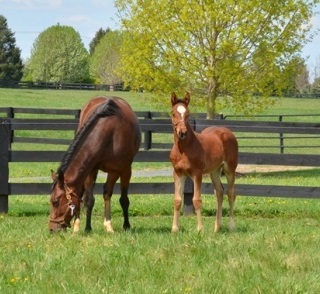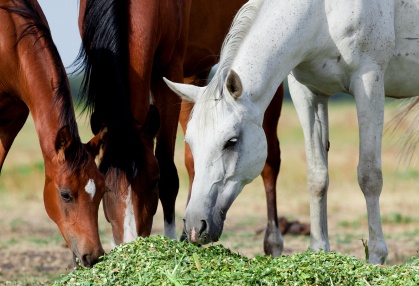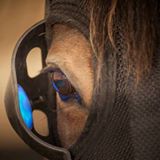 Older mares have a knack for being the sweetest and gentlest mares on the farm. We see them year after year, either carrying their own foals or returning to donate embryos if their reproductive status requires. Oftentimes, these mares are considered “special” patients, requiring a unique combination of diet, exercise, and metabolic support to maintain their physical and reproductive health. We often see older performance mares that are being bred for the first time following a long and successful show career. Reproductive problems such as cervical adhesions and uterine infection can be common in older mares which affect their ability to carry a foal or donate an embryo.
Older mares have a knack for being the sweetest and gentlest mares on the farm. We see them year after year, either carrying their own foals or returning to donate embryos if their reproductive status requires. Oftentimes, these mares are considered “special” patients, requiring a unique combination of diet, exercise, and metabolic support to maintain their physical and reproductive health. We often see older performance mares that are being bred for the first time following a long and successful show career. Reproductive problems such as cervical adhesions and uterine infection can be common in older mares which affect their ability to carry a foal or donate an embryo.
For owners looking for guidance in preparing an older mare for breeding and pregnancy, our advice is to get your mare to an optimum body condition and take care of all veterinary procedures prior to the onset of the season. We attempt to cover the following areas in this article:
- General Healthcare
- Diet Modifications
- Specific Metabolic Disease
- Reproductive Health
General Healthcare
As with all breeding horses, these mares should be currently vaccinated for the core vaccines of EWT, Rabies, Tetanus and West Nile Virus as recommended by the AAEP along with specific risk based vaccines recommended from your local veterinarian. These should be administered 30 days prior to active breeding to allow an adequate immune response prior to introducing the mares to a new environment. Dental work should be up to date and any procedures needing sedation should be performed prior to active breeding. Some practitioners may also choose to address lameness issues that may require intra-articular injections. Although not necessarily a concern during early pregnancy, making mares more comfortable at turnout and during exercise can help manage intra-uterine fluid issues at the time of breeding.
Diet Modifications
Aged mares can be difficult to maintain in adequate flesh. If no predisposing metabolic disease is present, some older mares may be difficult to maintain at the optimal body condition scoring (BCS) of 5/9. We try to feed these mares at a higher plane of nutrition to achieve a BCS of 6/9 at the start of the season. I only recommend this for mares without history of arthritic, tendon, or suspensory issues that would be exacerbated by increasing the weight of the horse. This may be heavier than many mares need to be in early gestation. However, by starting at a heavier point before the season, I find it easier to maintain this weight during the first two trimesters of pregnancy.  I use a combination of a high protein ration balancer, fat supplements, and alfalfa hay as needed which contributes a good amount of protein through roughage. Our feeding routine not only puts mares in a positive energy balance through conception and early pregnancy but also allows them to carry adequate flesh through the hotter summer months when dry matter intake tends to decrease. Visit our article Feeding For Conception for additional information regarding BCS and broodmares. We use blankets during the coldest part of winter to help insulate and prevent excessive energy from being partitioned for heat generation and make sure good quality hay is always available to help generate body heat.
I use a combination of a high protein ration balancer, fat supplements, and alfalfa hay as needed which contributes a good amount of protein through roughage. Our feeding routine not only puts mares in a positive energy balance through conception and early pregnancy but also allows them to carry adequate flesh through the hotter summer months when dry matter intake tends to decrease. Visit our article Feeding For Conception for additional information regarding BCS and broodmares. We use blankets during the coldest part of winter to help insulate and prevent excessive energy from being partitioned for heat generation and make sure good quality hay is always available to help generate body heat.
Specific Metabolic Disease
In our practice, if we have a suspicion of Pituitary Pars Intermedia Dysfunction (PPID – commonly known as Cushing’s Disease) or Equine Metabolic Syndrome, we test prior to the season so that we can begin therapy and regulate the disease process. By regulating the disease prior to breeding, we hopefully minimize any deleterious effects upon the mare’s cycle and eliminate the need to make large changes to a mare’s management during early pregnancy. For mares with chronic weight loss or inability to increase weight, I also pull a blood serum chemistry looking for renal disease and/or liver disease.
Reproductive Health
After assessing the overall health of the mare, the focus changes to assessing her reproductive health. Part of the physical exam includes an assessment of perineal conformation and mammary gland dynamics. I consider testing for PPID if a mare has failed to dry up considerably or failed to shed much of her hair coat. Inappropriate lactation is one clinical sign of PPID and for mares that fail to dry up following weaning they may have early clinical stages of PPID. Increasing the mare’s weight can help correct poor perineal conformation. However, mares that have severe inward sloping of the vulva may require further intervention and aggressive uterine therapy and a Caslick’s procedure following breeding. In all older mares a pre-breeding culture and cytology and speculum exam is performed. This allows me to confirm a healthy uterine environment for conception and evaluate the mare’s cervix for signs of previous cervical tearing, scarring, or adhesions. For those older maiden mares this exam provides information on the degree of cervical fibrosis that has occurred that may make post mating induced endometritis (PMIE) more difficult to manage. For additional information on what to consider prior to breeding your mare please visit our article, Preparing Your Mare for Breeding.
Artificial Lighting
Lastly, I put the mares under a supplemental lighting program starting 60 days prior to when the owners want to begin breeding. By increasing the photoperiod to 16 hours/day with supplemental light and by increasing caloric intake, most mares begin to cycle normally within 60 days. Some older mares, especially over age 20, experience irregular inter-estrus intervals and have difficulty having normal ovulations as they approach ovarian senescence.  Using artificial light to induce mares to ovulate as early as possible in the breeding season enables us to prolong the season and have the most amount of time to settle some difficult mares into foal or into donating embryos. Additional information about artificial lighting can be found in our articles; Hastening the Onset of Breeding Season and New Alternative to Putting Your Mare Under Lights.
Using artificial light to induce mares to ovulate as early as possible in the breeding season enables us to prolong the season and have the most amount of time to settle some difficult mares into foal or into donating embryos. Additional information about artificial lighting can be found in our articles; Hastening the Onset of Breeding Season and New Alternative to Putting Your Mare Under Lights.
Semen Quality
As an aside, I usually have a discussion with breeding managers about the stallion and the semen availability of their chosen stud. I want to make sure the stallion provides good quality cooled or frozen semen with adequate sperm numbers to facilitate conception. For mares without PMIE issues and without cervical fibrosis, I advise clients to pick stallions where multiple doses of cooled or frozen semen are available. Since older mares may have slightly irregular ovulatory patterns, I like to have more semen available in case I decide to breed the mare at a smaller follicle size if other signs of impending ovulation are present. If mares have cervical fibrosis, I advise clients to pick a stallion with above average fertility and if the fertility is not known, above average motility characteristics of his cooled or frozen semen. Mares with cervical fibrosis are best only bred once per cycle. The chance of obtaining a pregnancy increase when a stallion with above average semen characteristics is chosen. Further information about semen quality can be found in our articles; What is Progressive Motility? and It Only Takes One Right?.
Following a systematic approach to maintaining older mares in optimal physical health helps them stay at optimum reproductive health. Even though these mares may be difficult to achieve pregnancies due to genetics and age related ovarian and uterine pathology, this approach can help minimize any secondary problems related to age and metabolic disease so that all energy, from both the mare and management staff can be applied to generating a pregnancy.





